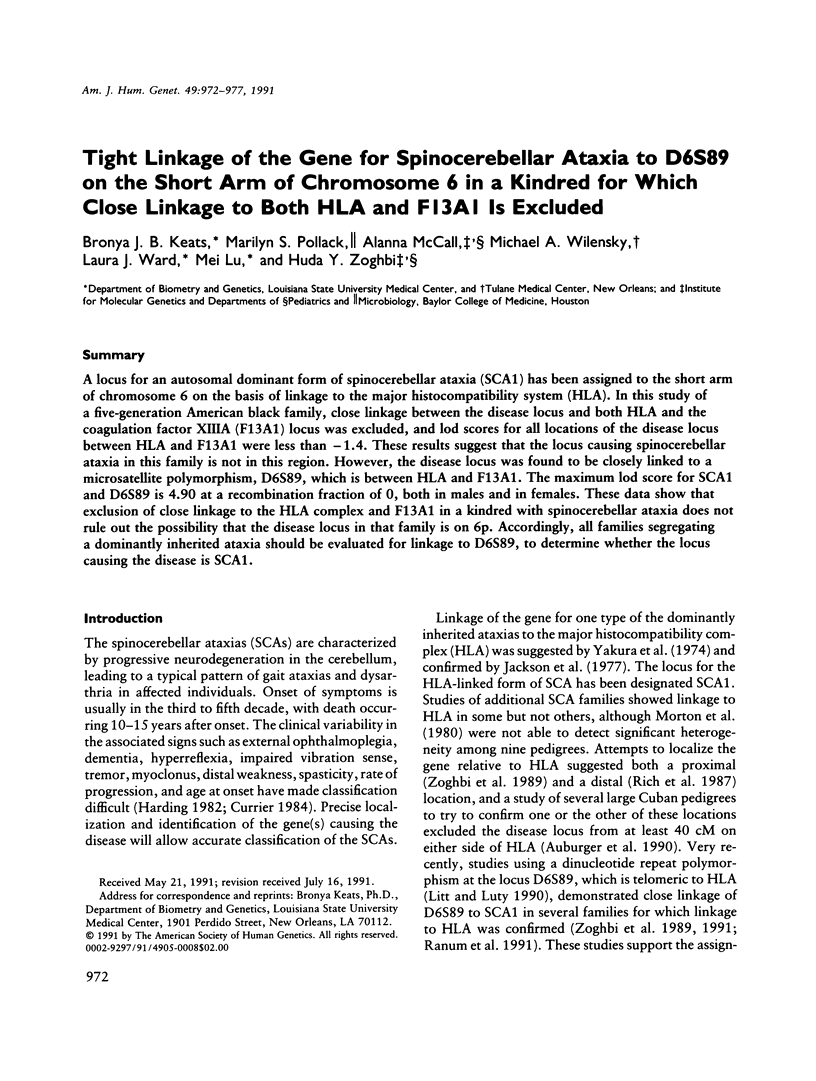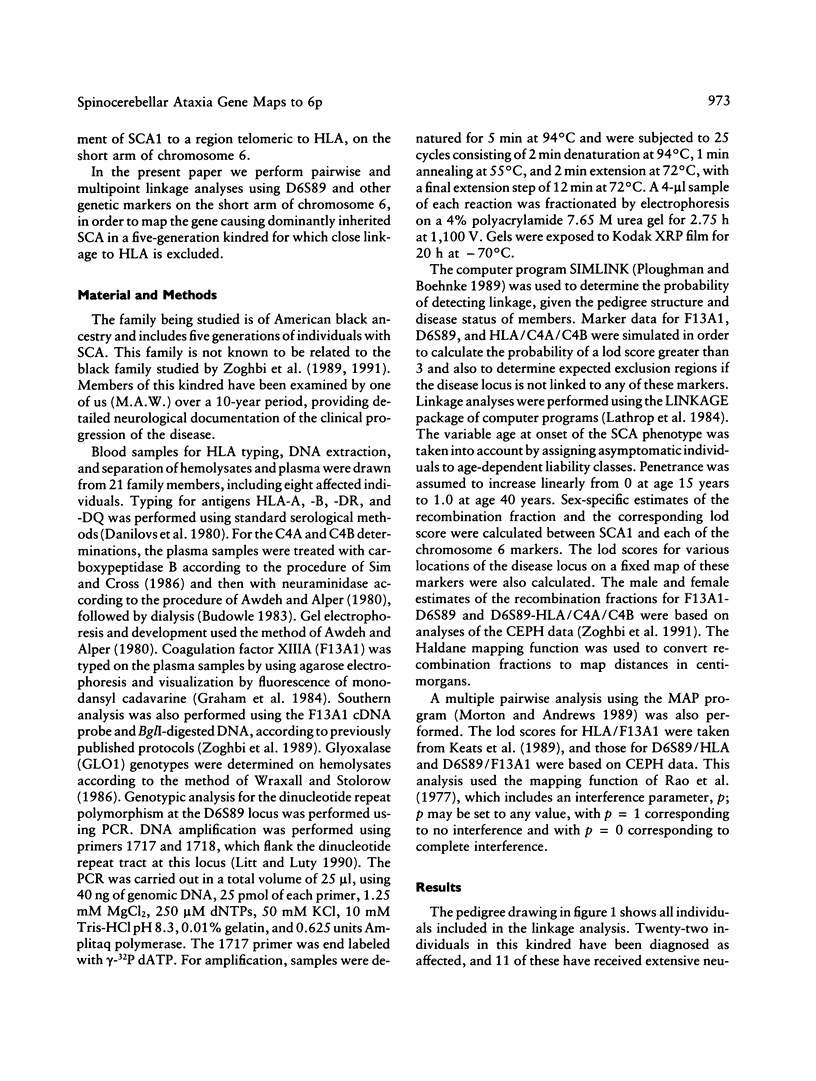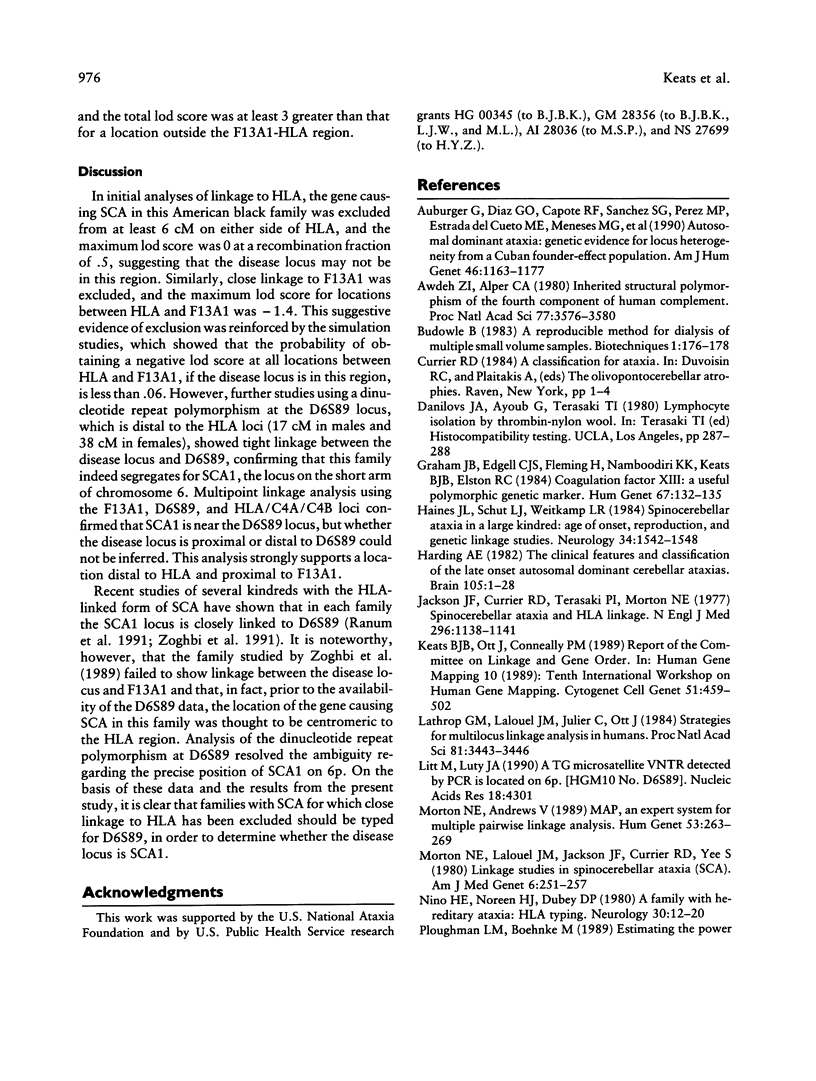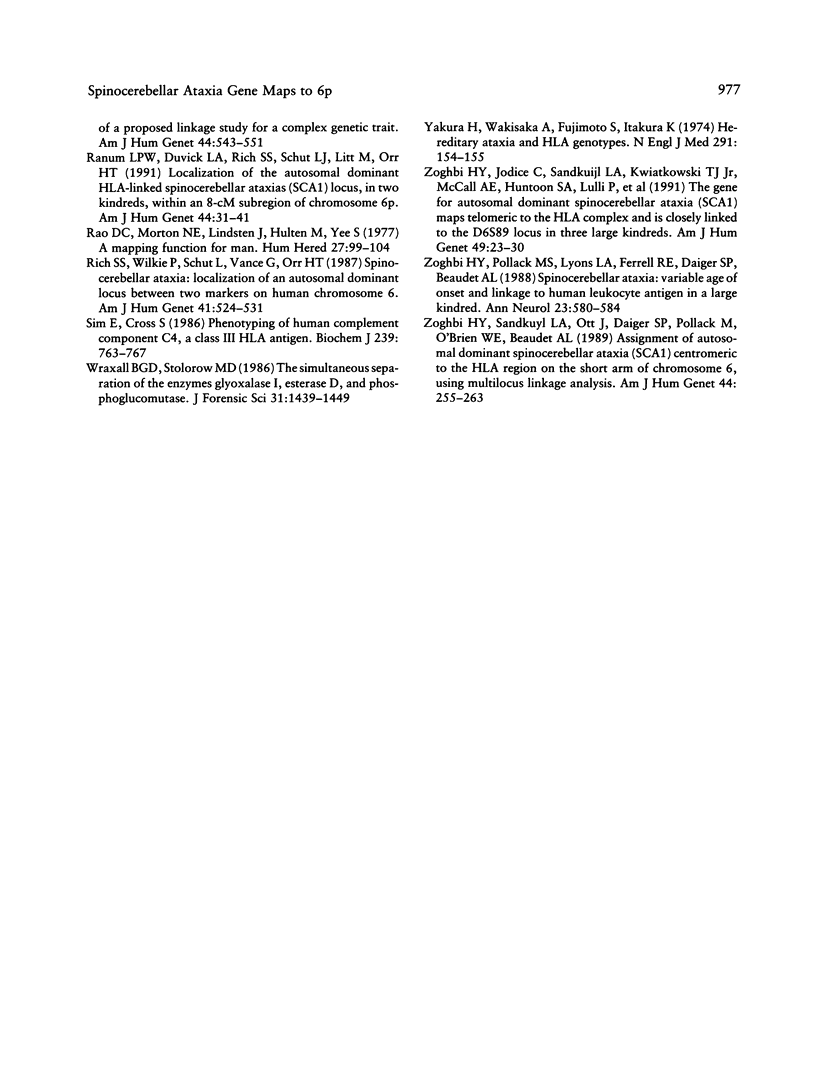Abstract
A locus for an autosomal dominant form of spinocerebellar ataxia (SCA1) has been assigned to the short arm of chromosome 6 on the basis of linkage to the major histocompatibility system (HLA). In this study of a five-generation American black family, close linkage between the disease locus and both HLA and the coagulation factor XIIIA (F13A1) locus was excluded, and lod scores for all locations of the disease locus between HLA and F13A1 were less than -1.4. These results suggest that the locus causing spinocerebellar ataxia in this family is not in this region. However, the disease locus was found to be closely linked to a microsatellite polymorphism, D6S89, which is between HLA and F13A1. The maximum lod score for SCA1 and D6S89 is 4.90 at a recombination fraction of 0, both in males and in females. These data show that exclusion of close linkage to the HLA complex and F13A1 in a kindred with spinocerebellar ataxia does not rule out the possibility that the disease locus in that family is on 6p. Accordingly, all families segregating a dominantly inherited ataxia should be evaluated for linkage to D6S89, to determine whether the locus causing the disease is SCA1.
Full text
PDF





Selected References
These references are in PubMed. This may not be the complete list of references from this article.
- Auburger G., Diaz G. O., Capote R. F., Sanchez S. G., Perez M. P., del Cueto M. E., Meneses M. G., Farrall M., Williamson R., Chamberlain S. Autosomal dominant ataxia: genetic evidence for locus heterogeneity from a Cuban founder-effect population. Am J Hum Genet. 1990 Jun;46(6):1163–1177. [PMC free article] [PubMed] [Google Scholar]
- Awdeh Z. L., Alper C. A. Inherited structural polymorphism of the fourth component of human complement. Proc Natl Acad Sci U S A. 1980 Jun;77(6):3576–3580. doi: 10.1073/pnas.77.6.3576. [DOI] [PMC free article] [PubMed] [Google Scholar]
- Graham J. B., Edgell C. J., Fleming H., Namboodiri K. K., Keats B. J., Elston R. C. Coagulation factor XIII: a useful polymorphic genetic marker. Hum Genet. 1984;67(2):132–135. doi: 10.1007/BF00272987. [DOI] [PubMed] [Google Scholar]
- Haines J. L., Schut L. J., Weitkamp L. R., Thayer M., Anderson V. E. Spinocerebellar ataxia in a large kindred: age at onset, reproduction, and genetic linkage studies. Neurology. 1984 Dec;34(12):1542–1548. doi: 10.1212/wnl.34.12.1542. [DOI] [PubMed] [Google Scholar]
- Harding A. E. The clinical features and classification of the late onset autosomal dominant cerebellar ataxias. A study of 11 families, including descendants of the 'the Drew family of Walworth'. Brain. 1982 Mar;105(Pt 1):1–28. doi: 10.1093/brain/105.1.1. [DOI] [PubMed] [Google Scholar]
- Jackson J. F., Currier R. D., Terasaki P. I., Morton N. E. Spinocerebellar ataxia and HLA linkage: risk prediction by HLA typing. N Engl J Med. 1977 May 19;296(20):1138–1141. doi: 10.1056/NEJM197705192962003. [DOI] [PubMed] [Google Scholar]
- Keats B., Ott J., Conneally M. Report of the committee on linkage and gene order. Cytogenet Cell Genet. 1989;51(1-4):459–502. doi: 10.1159/000132805. [DOI] [PubMed] [Google Scholar]
- Lathrop G. M., Lalouel J. M., Julier C., Ott J. Strategies for multilocus linkage analysis in humans. Proc Natl Acad Sci U S A. 1984 Jun;81(11):3443–3446. doi: 10.1073/pnas.81.11.3443. [DOI] [PMC free article] [PubMed] [Google Scholar]
- Litt M., Luty J. A. Dinucleotide repeat polymorphism at the D6S89 locus. Nucleic Acids Res. 1990 Jul 25;18(14):4301–4301. doi: 10.1093/nar/18.14.4301. [DOI] [PMC free article] [PubMed] [Google Scholar]
- Morton N. E., Andrews V. MAP, an expert system for multiple pairwise linkage analysis. Ann Hum Genet. 1989 Jul;53(Pt 3):263–269. doi: 10.1111/j.1469-1809.1989.tb01793.x. [DOI] [PubMed] [Google Scholar]
- Morton N. E., Lalouel J. M., Jackson J. F., Currier R. D., Yee S. Linkage studies in spinocerebellar ataxia (SCA). Am J Med Genet. 1980;6(3):251–257. doi: 10.1002/ajmg.1320060309. [DOI] [PubMed] [Google Scholar]
- Nino H. E., Noreen H. J., Dubey D. P., Resch J. A., Namboodiri K., Elston R. C., Yunis E. J. A family with hereditary ataxia: HLA typing. Neurology. 1980 Jan;30(1):12–20. doi: 10.1212/wnl.30.1.12. [DOI] [PubMed] [Google Scholar]
- Ploughman L. M., Boehnke M. Estimating the power of a proposed linkage study for a complex genetic trait. Am J Hum Genet. 1989 Apr;44(4):543–551. [PMC free article] [PubMed] [Google Scholar]
- Ranum L. P., Duvick L. A., Rich S. S., Schut L. J., Litt M., Orr H. T. Localization of the autosomal dominant HLA-linked spinocerebellar ataxia (SCA1) locus, in two kindreds, within an 8-cM subregion of chromosome 6p. Am J Hum Genet. 1991 Jul;49(1):31–41. [PMC free article] [PubMed] [Google Scholar]
- Rao D. C., Morton N. E., Lindsten J., Hultén M., Yee S. A mapping function for man. Hum Hered. 1977;27(2):99–104. doi: 10.1159/000152856. [DOI] [PubMed] [Google Scholar]
- Rich S. S., Wilkie P., Schut L., Vance G., Orr H. T. Spinocerebellar ataxia: localization of an autosomal dominant locus between two markers on human chromosome 6. Am J Hum Genet. 1987 Oct;41(4):524–531. [PMC free article] [PubMed] [Google Scholar]
- Sim E., Cross S. J. Phenotyping of human complement component C4, a class-III HLA antigen. Biochem J. 1986 Nov 1;239(3):763–767. doi: 10.1042/bj2390763. [DOI] [PMC free article] [PubMed] [Google Scholar]
- Wraxall B. G., Stolorow M. D. The simultaneous separation of the enzymes glyoxalase I, esterase D, and phosphoglucomutase. J Forensic Sci. 1986 Oct;31(4):1439–1449. [PubMed] [Google Scholar]
- Yakura H., Wakisaka A., Fujimoto S., Itakura K. Letter: Hereditary ataxia and HL-A. N Engl J Med. 1974 Jul 18;291(3):154–155. doi: 10.1056/NEJM197407182910314. [DOI] [PubMed] [Google Scholar]
- Zoghbi H. Y., Jodice C., Sandkuijl L. A., Kwiatkowski T. J., Jr, McCall A. E., Huntoon S. A., Lulli P., Spadaro M., Litt M., Cann H. M. The gene for autosomal dominant spinocerebellar ataxia (SCA1) maps telomeric to the HLA complex and is closely linked to the D6S89 locus in three large kindreds. Am J Hum Genet. 1991 Jul;49(1):23–30. [PMC free article] [PubMed] [Google Scholar]
- Zoghbi H. Y., Pollack M. S., Lyons L. A., Ferrell R. E., Daiger S. P., Beaudet A. L. Spinocerebellar ataxia: variable age of onset and linkage to human leukocyte antigen in a large kindred. Ann Neurol. 1988 Jun;23(6):580–584. doi: 10.1002/ana.410230609. [DOI] [PubMed] [Google Scholar]
- Zoghbi H. Y., Sandkuyl L. A., Ott J., Daiger S. P., Pollack M., O'Brien W. E., Beaudet A. L. Assignment of autosomal dominant spinocerebellar ataxia (SCA1) centromeric to the HLA region on the short arm of chromosome 6, using multilocus linkage analysis. Am J Hum Genet. 1989 Feb;44(2):255–263. [PMC free article] [PubMed] [Google Scholar]


